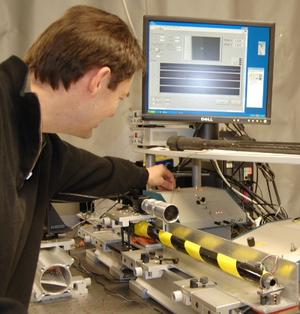Law enforcement/military technologyNew rifle sighting system dramatically improves accuracy
Crosshairs automatically adjust for conditions in real time; a fiber-optic laser-based sensor system automatically corrects for even tiny barrel disruptions; the system, developed at Oak Ridge National Laboratory’s (ORNL), precisely measures the deflection of the barrel relative to the sight and then electronically makes the necessary corrections; the new sensor is 250 times better than that of traditional crosshairs, which can be manually adjusted by one-fourth minutes of angle; the ORNL sensor can sense angular displacement and shift the reticle (crosshairs) by 1/1,000th of a minute of angle

Developer Slobodan Rajic fine-tunes prototype // Source: ornl.gov
Military and police marksmen will soon see their rifle sights catch up with the twenty-first century with a fiber-optic laser-based sensor system that automatically corrects for even tiny barrel disruptions.
The system, developed by a team led by Oak Ridge National Laboratory’s (ORNL) Slobodan Rajic, precisely measures the deflection of the barrel relative to the sight and then electronically makes the necessary corrections. The lifesaving results are lethal.
“For military snipers, missing the target could allow high-profile terrorists to escape,” Rajic said. “For police marksmen, missing the kidnapper could endanger the lives of hostages and then pose subsequent danger to police officers and the public.” The ORNL release notes that the Reticle Compensating Rifle Barrel Reference Sensor takes the guesswork out of shooting by shifting the burden of knowing the relative position between the barrel and the weapon sight axes from the shooter to an electronic sensor. The system precisely measures the deflection of the barrel relative to the sight and then electronically realigns the moving reticle, or crosshairs, with the true position of the barrel, or bore axis.
“When a weapon is sighted in, the aim point and bullet point of impact coincide,” Rajic said. “However, in the field, anything that comes into contact with the barrel can cause perturbation of the barrel and induce errors.”
With modern high-caliber rifles boasting ranges of up to two miles, even very small barrel disruptions can cause a shooter to miss by a wide margin. That makes this technology indispensable from a marksman’s perspective, Rajic said.
From a technological standpoint, the approach is straightforward. The typical barrel of a high-power rifle has exterior grooves, called flutes, to reduce weight and create more surface area to enable the barrel to cool faster. The barrel heats up as a result of the hot expanding gases in the barrel and the friction from the bullets that are propelled by these hot gases along a helical path inside the barrel.
With the ORNL technology, glass optical fibers are placed into the flutes. These flutes are either produced by the barrel manufacturer or subsequently retrofit. The sensor system contains a laser diode that sends a signal beam into the optical fibers parallel to the bore axis of the barrel.
“The optical fibers are designed to split the laser beam twice, sending one beam along the top of the rifle barrel and another light beam along the side of the barrel,” Rajic said. “Thus, we can measure both the vertical and horizontal barrel deflection.”
Through a combination of algorithms, optics, and additional sensor inputs, the system can take into account distance and other factors affecting the bullet trajectory. Ultimately the shooter is left with crosshairs that automatically adjust for conditions in real time.
In the end, the resolution of ORNL’s Reticle Compensating Rifle Barrel Reference Sensor is 250 times better than that of traditional reticles, which can normally be manually adjusted by one-fourth minutes of angle whereas the ORNL sensor can sense angular displacement and shift the reticle by 1/1,000th of a minute of angle, Rajic said.
Rajic and colleagues are also developing a laser-based bullet tracking system to give the shooter even better odds of succeeding by providing specific information about the bullet flight path.
ORNL notes that other developers of the technology are Panos Datskos, Troy Marla, and Bill Lawrence. Funding for the project has been provided by the U.S. Army, Picatinny Arsenal, Joint Services Small Arms Program.
